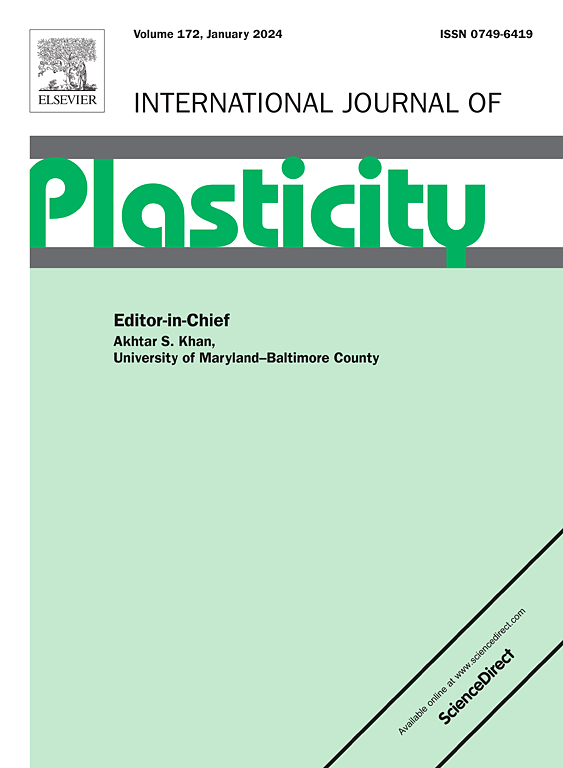岩石摩擦断裂的热力学一致相场模型
IF 9.4
1区 材料科学
Q1 ENGINEERING, MECHANICAL
引用次数: 0
摘要
地质介质中的摩擦断裂现象往往与地震中的断层失稳和地质灾害中的滑面形成密切相关。在这项工作中,我们提出了一种新的相场模型,用于捕获压力敏感岩土材料中的摩擦裂缝。我们的模型具有三个新特征:(i)接触和摩擦条件下的热力学一致的能量界面;(ii)结合一个水平集函数来耦合相场演化和摩擦接触滑移;(3)从存储能量到屈服的过渡,用于描述不同的类塑性粘滑摩擦裂缝。基于能量守恒定律和虚功的变分不等式,建立了摩擦断裂的控制方程,包括动力学平衡方程、相场演化定律,以及最重要的摩擦界面类塑性驱动力。我们还提出了一种强大的数值技术来处理岩石中摩擦裂缝的时空形成和演化。我们通过模拟几个基准示例来验证模型。我们的模型被证明可以再现岩石中的摩擦粘和滑动现象。我们还应用该模型研究了围压对岩石摩擦裂纹萌生和扩展的影响,这有助于我们更好地理解摩擦破裂的深层机制。本文章由计算机程序翻译,如有差异,请以英文原文为准。
A thermodynamically consistent phase-field model for frictional fracture in rocks
Frictional fracture phenomena in geological media are often closely related to fault instability in earthquakes and slip surface formation in geohazards. In this work, we propose a new phase-field model for capturing frictional fractures in pressure-sensitive geomaterials. Our model has three novel features: (i) a thermodynamically consistent energetic interface for contact and friction conditions; (ii) incorporation of a level set function to couple phase-field evolution and frictional-contact slips; and (iii) a transition from stored energy to yielding for describing different plastic-like frictional stick–slip fractures. Based on the energy conservation law and a variational inequality of virtual work, we formulate the governing equations for frictional fractures, including the dynamic equilibrium equation, phase-field evolution law, and most importantly, frictional interface plastic-like driving forces. We also present a robust numerical technique to handle the spatiotemporal formation and evolution of frictional fractures in rocks. We validate the model by simulating several benchmark examples. Our model is shown to reproduce both frictional stick and slip phenomena in rocks. We also apply this model to study the effect of confining pressure on frictional crack initiation and propagation in rocks, which helps us better understand the deep mechanisms of frictional fracture.
求助全文
通过发布文献求助,成功后即可免费获取论文全文。
去求助
来源期刊

International Journal of Plasticity
工程技术-材料科学:综合
CiteScore
15.30
自引率
26.50%
发文量
256
审稿时长
46 days
期刊介绍:
International Journal of Plasticity aims to present original research encompassing all facets of plastic deformation, damage, and fracture behavior in both isotropic and anisotropic solids. This includes exploring the thermodynamics of plasticity and fracture, continuum theory, and macroscopic as well as microscopic phenomena.
Topics of interest span the plastic behavior of single crystals and polycrystalline metals, ceramics, rocks, soils, composites, nanocrystalline and microelectronics materials, shape memory alloys, ferroelectric ceramics, thin films, and polymers. Additionally, the journal covers plasticity aspects of failure and fracture mechanics. Contributions involving significant experimental, numerical, or theoretical advancements that enhance the understanding of the plastic behavior of solids are particularly valued. Papers addressing the modeling of finite nonlinear elastic deformation, bearing similarities to the modeling of plastic deformation, are also welcomed.
 求助内容:
求助内容: 应助结果提醒方式:
应助结果提醒方式:


